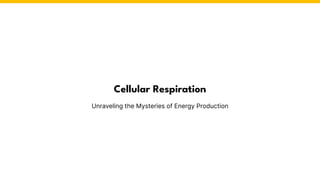
Cellular Respiration High School Biology Level
- 1. Cellular Respiration Unraveling the Mysteries of Energy Production
- 2. Goal of Cellular Respiration ● Make ATP!!
- 3. Introduction to Cellular Respiration ● Cellular respiration is the process by which cells break down glucose and other organic molecules to release energy. ● It is a critical process that occurs in all living organisms. ● Cellular respiration takes place in the mitochondria, which are the powerhouses of the cells. ● The process involves several steps, including glycolysis, the Krebs cycle, and the electron transport chain. Photo by Pexels
- 4. Parts of a Mitochondria ● Outer membrane ● Inner membrane: contains carrier proteins for creating gradient and making ATP ● Cristae: inner membrane folds increase surface area ● Matrix: most internal cytosol holds enzymes for link reaction & Krebs ● Intermembrane space: H+ electrochemical gradient builds up within
- 5. Big Picture Concepts of Cellular Respiration Glycolysis -Break down 6 Carbon Glucose into 2 3-Carbon pyruvates Pyruvate Oxidation Krebs/ Citric Acid Cycle Oxidative Phosphorylation -Get the Carbons into the mitochondrial matrix A)Recycle all the Carbons B) Make electron/energy carriers -Make ATP by creating an electrochemical gradient with H+
- 6. Big Picture Concepts of Cellular Respiration Glycolysis -Break down 6 Carbon Glucose into 2 3-Carbon pyruvates Pyruvate Oxidation Krebs/ Citric Acid Cycle Oxidative Phosphorylation -Get the Carbons into the mitochondrial matrix A)Recycle all the Carbons B) Make electron/energy carriers -Make ATP by creating an electrochemical gradient with H+ In the Cytoplasm In the Mitochondrial membrane In the Mitochondrial matrix In the Mitochondrial
- 7. 1) Glycolysis- Overview ● Glycolysis is the first step of cellular respiration. ● It takes place in the cytoplasm and converts glucose into pyruvate. ● During glycolysis, a small amount of ATP is produced, along with NADH and pyruvate. ● This step does not require oxygen and is therefore considered anaerobic.
- 8. 1) Glycolysis- In detail
- 9. 1) Glycolysis- In detail
- 10. 1) Glycolysis- what YOU need to know
- 11. The Krebs Cycle ● The Krebs cycle, also known as the citric acid cycle, is the second step of cellular respiration. ● It takes place in the mitochondria and generates energy-rich molecules like NADH and FADH2. ● The Krebs cycle also produces ATP directly. ● This step requires oxygen and is therefore considered aerobic. Photo by Pexels
- 12. Electron Transport Chain ● The electron transport chain is the final step of cellular respiration. ● It takes place in the inner mitochondrial membrane and produces the majority of ATP. ● NADH and FADH2 produced in previous steps donate electrons to the chain. ● This creates a gradient that drives ATP synthesis through oxidative phosphorylation. Photo by Pexels
- 13. Energy Yield of Cellular Respiration ● Cellular respiration produces a net of 36-38 ATP molecules for each glucose molecule. ● This energy is used by cells to fuel their various activities. ● The exact yield may vary depending on different factors, such as the efficiency of the electron transport chain. ● The energy yield of cellular respiration is much higher compared to anaerobic processes like fermentation. Photo by Pexels
- 14. Role of Oxygen ● Oxygen plays a crucial role in cellular respiration. ● It serves as the final electron acceptor in the electron transport chain. ● Without oxygen, the electron transport chain cannot operate efficiently. ● The absence of oxygen leads to the accumulation of NADH and FADH2, causing a cellular energy crisis. Photo by Pexels
- 15. Relationship with Photosynthesis ● Cellular respiration and photosynthesis are interconnected processes in nature. ● Photosynthesis produces oxygen and glucose, which serve as inputs for cellular respiration. ● The waste products of cellular respiration, carbon dioxide and water, are used by plants in photosynthesis. ● These processes maintain a delicate balance of gases and energy in the biosphere. Photo by Pexels
- 16. Cellular Respiration in Health and Disease ● Cellular respiration is essential for the survival and function of cells. ● Disruptions in cellular respiration can lead to various health conditions and diseases. ● Certain genetic disorders affect the energy production process in mitochondria. ● Understanding cellular respiration can provide insights into the diagnosis and treatment of these disorders. Photo by Pexels